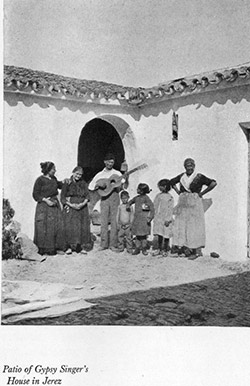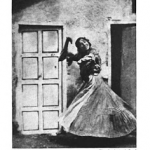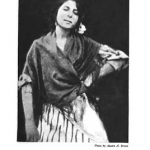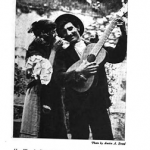
This is an image from the non-fiction volume, ‘Nights and Days On the Gypsy Trail’ published in 1922. Written by an American of Gypsy descent, Irving Brown, I finally obtained a copy of this book that I had heard about, but never actually seen available. To be fair, I was looking for a 1st. Edition and not a reprint.
Reviewer ‘Black Cat’ rated this 3 stars out of 5 on goodreads.com. This is what he says:
“The author, Irving Brown, travels to different cities in Spain looking for Spanish Gypsies: their folklore, music, customs, language and more… The book reveals the nature of the spanish gypsy: care-free, passionate, lyric, impulsive and generous with their “kind.”
Not exactly illuminating – but accurate.
I started out reading this curiosity and not very long into the book, had a distinct feeling that this book, written in purple prose, was nothing but a paen to a nostalgic view of Andalusian gypsies that never existed. But I persevered and read on a bit further.
At some point thereafter, I thought: this book is written in 1921 and who am I to pass judgement on what was the reality of Gypsy culture in Andalusia throughout this period.
With descriptions like this:
“…IMAGINE yourselves in a square cave hollowed from the rock. A little Spanish Gypsy girl is dancing an abulea to the accompaniment of a wild song and the vibrant notes of a guitar. Other Gypsies sitting tensely on the rims of their chairs, in a half circle about the dancer, are beating time with vigorous handclaps, and shouting, ” Alsa! Alsa!” in tones that make the stone vault re-echo. Dancer and audience are as one, in a frenzy of excitement. The tiny feet stamp the rough floor; the gaily colored skirt flutters as she springs. Her elastic body bends and sways. There is something of the snake and something of the bird, in the writhing arms and quivering fingers. There is a glitter in her eye, whether she strikes her bosom in mock rage, or leaps with head thrown back and lips parted in a paroxysm of joy. And an answering sparkle illumines the eye of every Gypsy.”
Well, I’ve seen that exact image played out at a tablao in 2009 in Seville, so this guy is not wrong (he just writes a hell of a lot better than me).



Images from Nights and Days On the Gypsy Trail
The book is divided into thirteen chapters. They are:
I. The Fascination of the Gypsy
II. Gypsies in Sun and Shadow: The Pyrenees and Barcelona
III. Laughing Cadiz
IV. Gypsies, Wine, and Song: Jerez
V. Gypsy Andalusia: Seville, Triana, Coria
VI. Picaresque Cordova
VII. Tangier the Untamed
VIII. Bootblacks and Troubadours: Málaga
IX. The Fair at Antequera
X. In The Shadow of The Jail: Granada
XI. Fantastic Guádix: The Smith’s Tale
XII. Gypsies in the Bull Ring: Joselito
XIII. Barcelona and Farewell
What eventually becomes apparent is this is a travelogue not much different in ethos from John Lloyd Stephens and Frederick Catherwood’s seminal travelogue of Maya México, Incidents of Travel in Yucatan, Vols. I and II.
The book reveals several things to me: the world was very different place in 1921, the description of places, people and incidents, especially in chapters 3, 4, 5, 8 and 12 are entirely consistent with smiliar descriptions given in D. E. Pohren’s books on Gypsy Flamenco (The Art of Flamenco, A Way of Life, and Lives and Legends of Flamenco).
If you can locate a copy of this book, it is worth reading not only for the surprisingly absorbing trip back in time, but it also provides insights into the personalities, interactions, beliefs and self-knowledge that the characters in The Stranger from Seville individually and collectively possess. In many respects, Béa Gonzalez’s book, albeit a work of fiction, distils the same literary insight into the human condition through the characters she has invented.
Now translating that into music is an entirely different matter!